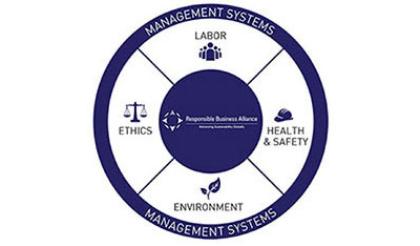Supplier Guidelines
Epson Group Supplier Guidelines / Epson Supplier Code of Conduct
Epson believes that it is essential for our business partners, including suppliers, to understand our management philosophy and support our procurement activities to realize that philosophy. For this reason, the Epson Group Supplier Guidelines include a code of conduct that we ask suppliers to follow.
We established our Group Procurement Guidelines in April 2005, intending to promote understanding of our procurement activities and cooperation in the promotion of CSR activities. In April 2008, we established the Epson Supplier Code of Conduct based on the Code of Conduct created by the Electronic Industry Citizenship Coalition (EICC), now called Responsible Business Alliance (RBA), as part of the Epson Group Guidelines, and have been revising it in line with revisions to the RBA Code of Conduct.
The Supplier Guidelines stipulate the basic quality (Q), price (C), and delivery (D) requirements for transactions, trade control measures that satisfy the requirements of the international community, and measures to ensure security in the supply chain. The Epson Supplier Code of Conduct (the RBA Code of Conduct) included in the Guidelines covers corporate social responsibility (CSR) requirements in such areas as labor, health and safety, environment, and ethics, with the aim of maintaining socially responsible business practices along with our business partners. More than 20 years have passed since the first edition of the guidelines was established, and in order to gain the understanding of suppliers located around the world, the Guidelines have been made available in multiple languages, with the current version 8.0 available in seven languages.
We have asked all suppliers to comply with the requirements and have asked our Major suppliers to sign a formal written agreement. Regarding Version 8.0 of the Supplier Guidelines revised in April 2024, of the companies (accounts) that were notified of the revisions, 2,916 (94.4%) agreed in writing to comply with the Guidelines. We also notify prospective suppliers about our Supplier Guidelines and ask them to pledge to observe the Guidelines prior to doing business with us.
As a member of the RBA, Epson is working to improve CSR across the supply chan.
Epson Group Supplier Guidelines (Group standard version) Ver8.0
- Japanese ver. 8.0 (906KB)
- English ver. 8.0 (378KB)
- Chinese ver. 8.0 (797KB)
- Spanish ver. 8.0 (405KB)
- Portuguese ver. 8.0 (391KB)
- Thai ver. 8.0 (578KB)
- Indonesian ver. 8.0 (394KB)
Hotline information is available here
Requirements of the RBA Code of Conduct
The Epson Supplier Code of Conduct, which is part of the Epson Group Supplier Guidelines, is based on the RBA Code of Conduct. It specifies requirements in the areas of labor, health and safety, environment, ethics, and management systems.
The RBA Code of Conduct requires not only compliance with local laws, but also with the requirements and standards of the RBA when they are more stringent than local laws. This idea ensures a certain level of management regardless of the legal requirements and standards of the countries and regions in which the supplier is located, and regardless of the labor practices of the area.

| A. LABOR (Human rights) | B. HEALTH AND SAFETY |
|---|---|
|
|
| C. ENVIRONMENT | D. ETHICS |
|
|
| E. MANAGEMENT SYSTEMS | |
|
|



